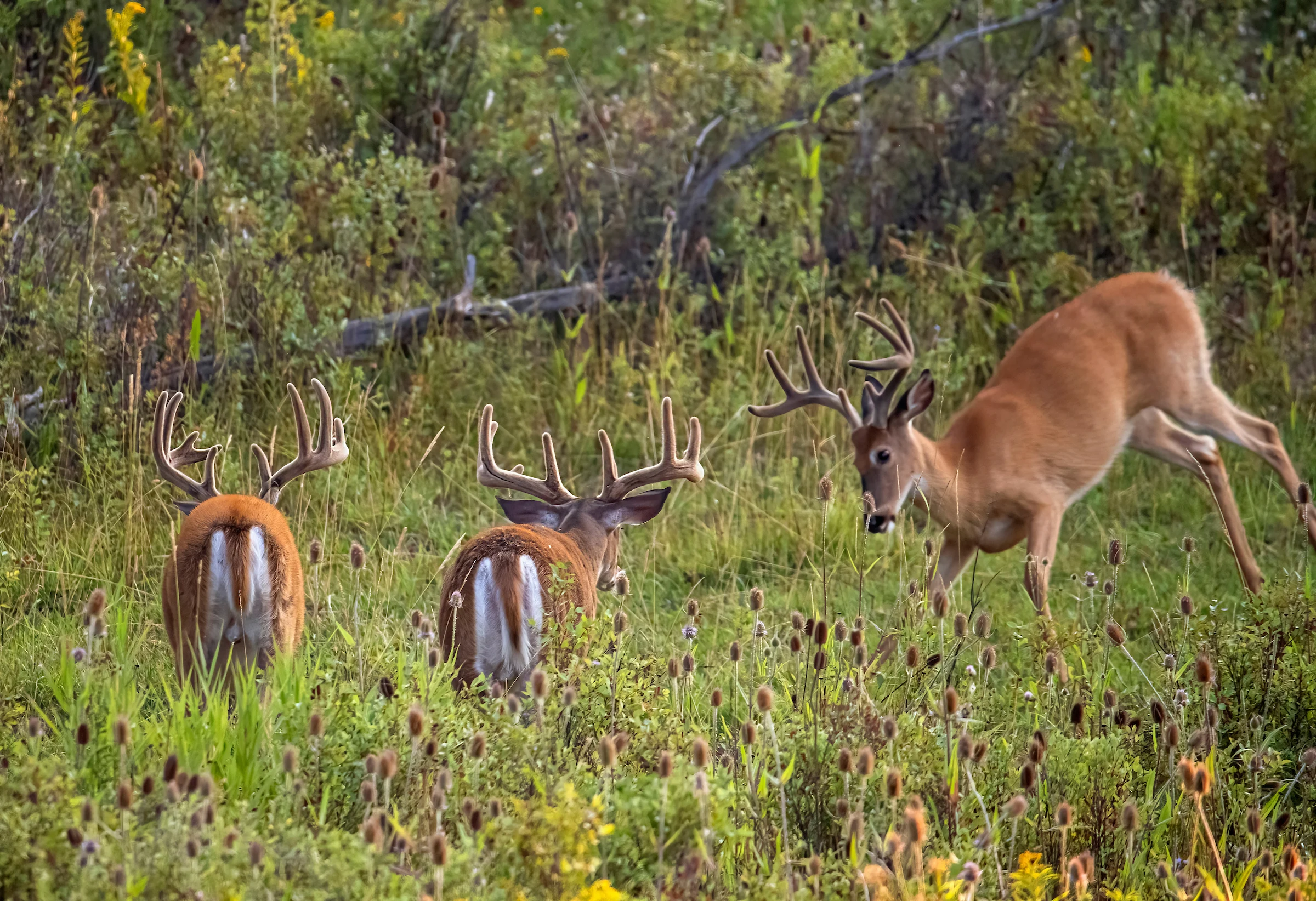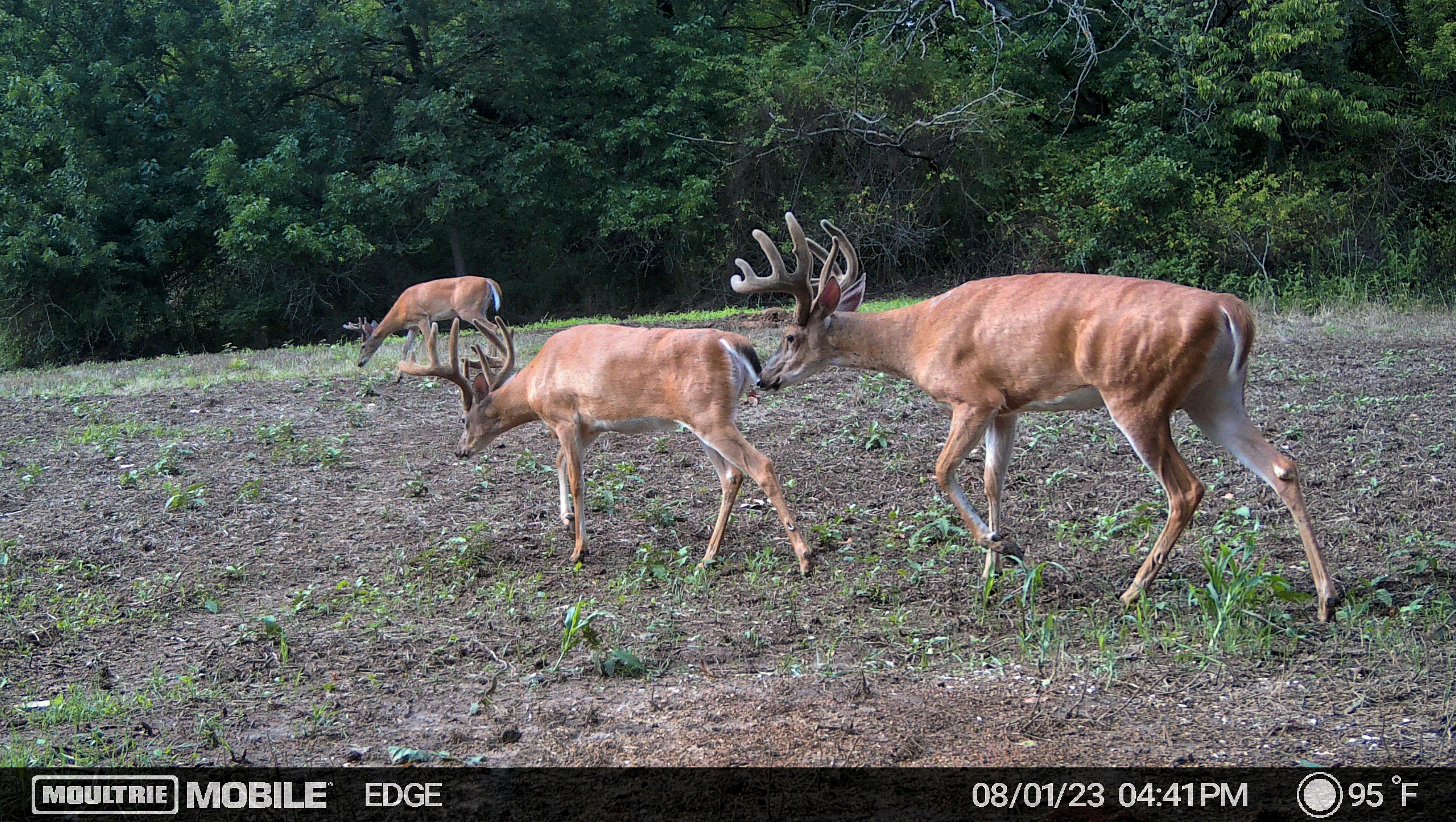If you're a whitetail nut, I don't know that there's any more exciting part of the offseason than late-summer and early fall, when bachelor groups of bucks start pouring into fields and food plots in the evenings to mill and feed. My buddies and I will hop in the truck this time of year and drive rural roads in the area, keeping an eye on alfalfa and soybean fields for feeding bucks. Even if I’m not going to hunt the properties we’re glassing, it’s always fun to watch groups of bucks feed and interact with each other.
An often overlooked and important scouting exercise this time of year is locating and studying bachelor groups of bucks. You can learn a lot about whitetails from observing them during this unique period of the year—including the best place to ambush them, if you are lucky enough that your early bow season opens before these buck bands break up. So with that in mind, here are seven key things you should know about bachelor bucks.
1. Bachelor Groups Form Early

While bachelor groups are normally associated with velvet-clad bucks in summer, many of these boy bands form immediately after the rut or in the first weeks of winter. I’ve watched bucks pair up and start running together in the immediate post-rut and stick together throughout the months ahead. While no one seems to know for certain why bucks form bachelor groups, the likeliest explanation is that a group of bucks simply has more eyes, ears, and noses to detect danger. Whitetails are typically pretty social critters, so it makes sense that they would seek the company and the safety of a group when not competing for breeding rights.
Related: 10 Expert Tips for Early Season Deer Hunting
2. Bachelor Bucks Are Homebodies
Summer's bands of velvet bucks tend to stick to relatively small areas, usually associated with a prime food source like soybeans or alfalfa. When I drive around with my buddies, we tend to see that same groups of bucks in the same fields night after night. If they do more, it's usually to a different nearby food source. This observation lines up nicely with science, which has shown that of all phases of the year, whitetail home range is smallest during the summer. And, of course, it's key intel for your early-season hunting plans.
3. They Don't Always Get Along

Obviously summer bucks are in full velvet and very protective of their rapidly growing–but tender antlers. So, they don’t engage in any sparring or fighting while in velvet, but they do have other ways of asserting authority. I’ve watched bachelor bucks posture, body-bump and kick at each other, especially as they jockey for position at food sources. All these aggressive maneuvers give bigger—or at least more aggressive—bucks the chance to say “I’m the boss” to other deer.
It should be noted that bachelor groups often stay intact for a time after velvet shed, and bucks are often anxious to spar and/or fight as soon as they enter hard antler, perhaps as a chance to finally settle things. In fact, several veteran hunters I know feel that some of the harshest buck fights of the season occur in early fall, their theory being that frustrated bucks can now use their headgear and make the most it. Also, a buck shifting his core area after velvet shed might encounter a strange buck and decide to duke it out.
4. They Can Be Key to Great Early-Season Hunting

It’s fairly well known that bachelor groups often break up shortly after velvet shed and that at least some of the deer may disperse. This fact causes some people to dismiss the importance of glassing summer bachelor groups when it comes to gleaning useful info for the hunting season. This is partly true, but not entirely, and here’s why.
Most of the dispersal that occurs following velvet shed is done by yearling bucks, who typically move to areas where they don’t have to mess with mature bucks. Meanwhile, the older deer that comprised the exciting element of the bachelor group, tend to stick around, especially if the late-summer/early-fall food source remains viable. Sometimes these mature bucks will maintain the highly visible feeding routines they exhibited in late summer. But even if they don’t, most of them won’t be far away and continued scouting and trail-cam work can reveal their new hangouts.
5. Not All Bucks Join the Party
While most bucks readily accept the companionship of other antlered buddies, there will always be a loner or two that wants nothing to do with other deer. In my experience, this is most likely to occur with older bucks, animals who’ve lived long enough to develop a unique personality. The largest buck I’ve ever tagged was a perfect example; while our cameras captured pics of a couple different bachelor groups on this farm, my hunting buddy and I noted that every pic of this 170-class buck was a solo shot. He simply seemed to prefer his own company and the night I arrowed him (the first week of Minnesota’s early archery season) he ignored the presence of four young bucks in a nearby food plot and headed toward the empty plot where I was waiting. I’ve noted several older bucks over the years that just seemed to prefer solitary life. This is important info: If the bachelor groups you’re observing don’t contain any whoppers, that doesn’t mean there isn’t a dandy living nearby.
Related: 12 Best Tree Stand Location for Early Season Deer Hunting
6. Bachelor Bucks Are Lazy

Telemetry has established that bucks (and other deer) have the smallest home range during summer. I’ll take this a step further and opine that they bed closer to food than at any time of the season, with the exception of the post-rut. During the late season, bucks bed close to food to conserve energy, but in the summer they do it for different reasons. In the farm country where I hunt, I’m convinced at least part of this strategy is insect avoidance; when mosquitoes, gnats and other nasties get thick, it’s pretty common to see whitetails (nice bucks included) feeding in open fields at midday. While hunger is an obvious factor, I believe they also just need a break from insect bites, so bedding within an easy walk to a field or opening makes perfect sense.
Also, whitetails, especially mature bucks, are basically lazy creatures, and they rarely travel farther than they have to when seeking food and cover. And since bucks are consuming a tremendous amount of calories during summer, why burn off a bunch of energy walking from bed to feed if you don’t have to? Veteran Kentucky guide Mark Clifford feels that early-fall bucks may bed less than 50 yards from a preferred food source; one reason why he never lets his clients hunt the mornings, as it’s nearly impossible to beat a buck back to his bedroom.
7. You Have to Hunt Them Carefully
It’s no secret that whitetails, but especially mature bucks, respond quickly once they sense hunting pressure. Telemetry studies have shown that deer that were once using fields and food plots during daylight in the summer, stopped doing once the hunting season was on. While it only took bucks a few days to respond to the influx of hunters in the woods during this study, it’s possible to buy yourself more time if you’re careful with stand placement, entry/exit, and not overhunting an area. Still, once you start invading a buck’s happy places, the clock is ticking on how long he feels comfortable there. And if you’re dealing with a multiple buck bachelor group, consider that clock to be humming even faster. The flip-side of this is if you hunt very carefully, you should have at least a few great cracks at a bruiser whitetail you've been watching all summer.



